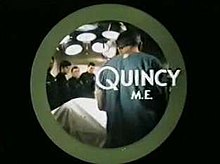
Back كوينسي إم إي Arabic كوينسى ARZ Quincy (tv-serie) Danish Quincy (Fernsehserie) German Quincy, M.E. Spanish Quincy (série télévisée) French Quincy (serie televisiva) Italian Dr.刑事クインシー Japanese 형사 Q Korean Quincy, M.E. Dutch
| Quincy, M.E. | |
|---|---|
 Title card | |
| Genre |
|
| Created by | |
| Starring |
|
| Theme music composer | Glen A. Larson & Stu Phillips |
| Opening theme | Original "Untitled" Score |
| Country of origin | United States |
| No. of seasons | 8 |
| No. of episodes | 148 (list of episodes) |
| Production | |
| Running time |
|
| Production companies |
|
| Original release | |
| Network | NBC |
| Release | October 3, 1976 – May 11, 1983 |
| Infobox instructions (only shown in preview) | |
Quincy, M.E. (also called Quincy) is an American mystery medical drama television series from Universal Studios that was broadcast on NBC from October 3, 1976, to May 11, 1983. Jack Klugman starred in the title role as a Los Angeles County medical examiner who routinely engages in police investigations.
Inspired by the book Where Death Delights by Marshall Houts, a former FBI agent,[1][2] the show also resembled the earlier Canadian television series Wojeck, broadcast by CBC Television. John Vernon, who played the Wojeck title role, later guest-starred in the third-season episode "Requiem for the Living". Quincy's character is loosely modeled on Los Angeles' "Coroner to the Stars" Thomas Noguchi.[3][4]
Quincy was originally broadcast as 90-minute telefilms as part of the NBC Sunday Mystery Movie rotation in the autumn of 1976, alongside Columbo, McCloud and McMillan (formerly McMillan & Wife). The series proved popular enough that after four episodes of Quincy, M.E. were broadcast during the 1976–1977 season in the extended format, Quincy was spun off into its own weekly one-hour series without a typical 60-minute pilot. Instead, a two-hour episode kicked off a thirteen-episode shortened run of the series, which concluded the 1976–1977 season, while NBC canceled the Mystery Movie format in the spring of 1977.
The Quincy series often used the same actors for different roles in various episodes, a frequent occurrence on many Glen A. Larson TV programs. Writers Lou Shaw and Tony Lawrence received an Edgar Award from the Mystery Writers of America in 1978 for the second-season episode "...The Thigh Bone's Connected to the Knee Bone...".
- ^ "Marshall Houts, 74, Author and Lawyer". The New York Times. November 30, 1993. Archived from the original on May 26, 2015. Retrieved October 13, 2012.
- ^ "Deaths: Marshall Houts". The Washington Post. November 29, 1993. Archived from the original (Fifth death notice on the page) on October 19, 2015. Retrieved October 18, 2012.
- ^ Hastings, Deborah (January 29, 1999). "Retiring 'coroner to stars' has no regrets". Chicago Sun-Times. Archived from the original on October 19, 2015. Retrieved October 18, 2012.
- ^ "Thomas Noguchi Biography". Who2. Retrieved October 18, 2012.